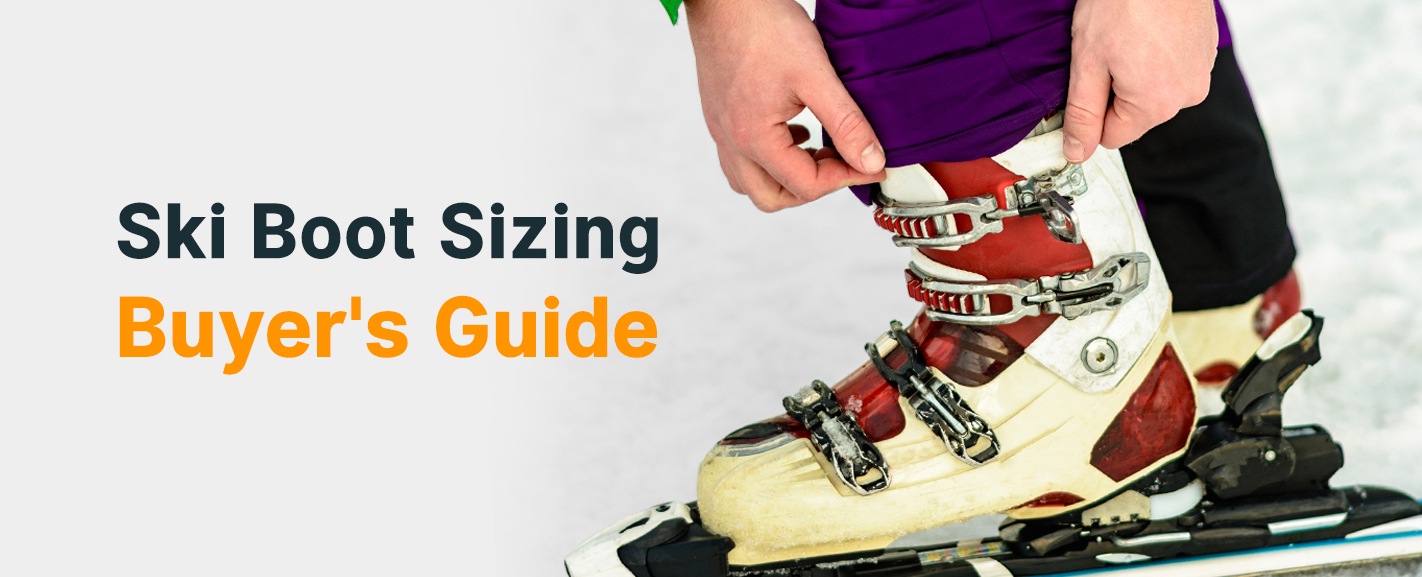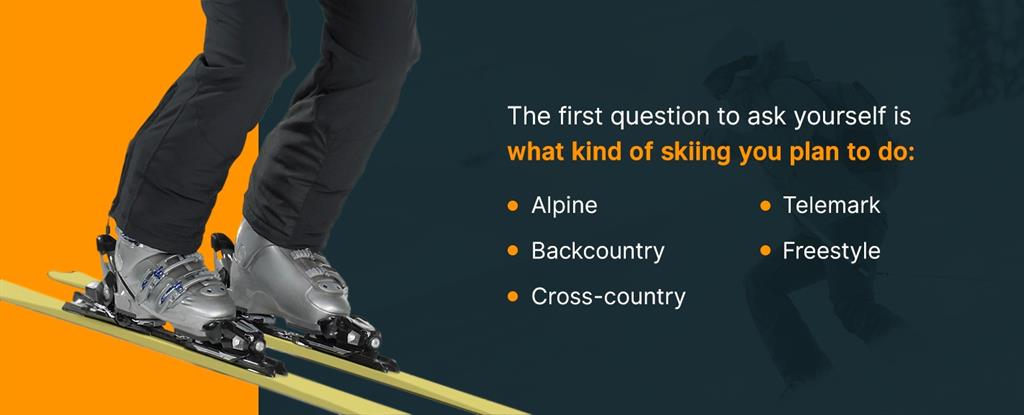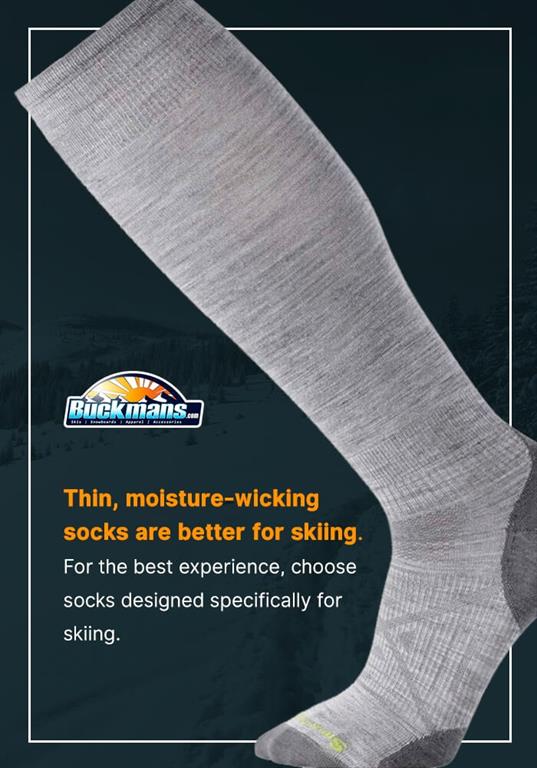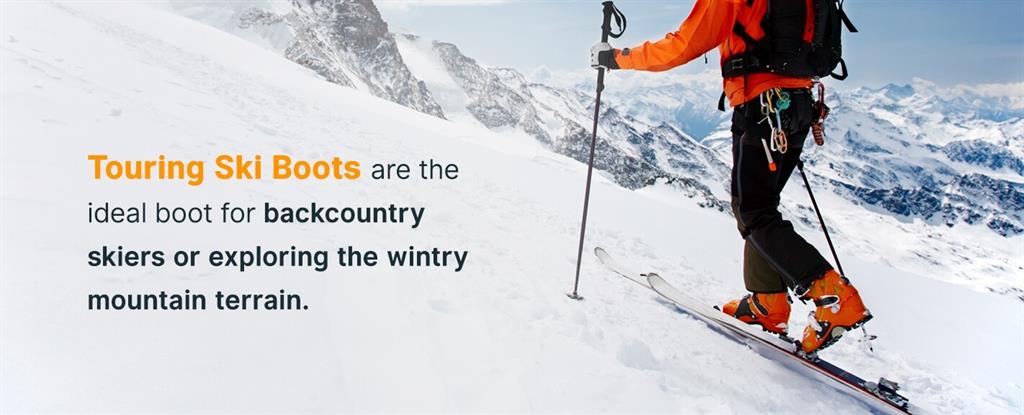 ski boot sizing buyer's guide
ski boot sizing buyer's guide
Ski Boot Sizing Buyer's Guide
Posted
by
Matt Gahman
on Friday, December 9, 2022
Properly fitting ski boots are essential for any skier, regardless of your experience level. You must know how to choose the best ski boots possible — that's why Buckman's has compiled a guide of everything you should consider when buying ski boots.
Determine Your Ski Boot Needs Based on Ability and Style
Here is what to know before buying ski boots:
- - What kind of skiing you do
- - Your experience level
- - What you want in a ski boot
- - Your ski boot fit
What Kind of Skier Are You?

The first question to ask yourself is what kind of skiing you plan to do.
- - Alpine: Also known as downhill skiing, this is the most common type of skiing. Most people who alpine ski do so at resorts.
- - Backcountry: Backcountry skiing refers to any skiing done outside a controlled skiing environment.
- - Cross-country: Cross-country skiing does not use slopes or inclines. Instead, it is skiing that you do to move across flat terrain. There are different types of cross-country skiing, including classic cross-country and skate skiing.
- - Telemark: Telemark skiing refers to the position of your heel and knee during skiing. Tele-skiers have a free, unfixed heel and bend one knee to propel. Telemark skiers need ski boots explicitly made for this type of skiing.
- - Freestyle: Freestyle skiers take advantage of their surroundings, no matter where they are. In this kind of skiing, the skier incorporates jumps and aerial twists for a more playful take on the sport.
Now, determine your experience level. If you are a first-time skier, you are a beginner. Those with some moderate slope experience are usually intermediate-level skiers. Advanced or expert skiers are those who have been skiing for a while and can handle more challenging trails.
- - Beginner: Ski boot fit for beginners should have a soft to medium-level flex and a comfortable liner. The more comfortable your ski boots are, the more time you can spend learning on the slopes.
- - Intermediate: As you take on more challenging slopes, you need a ski boot that provides plenty of control. Intermediate skiers should look for boots with a medium-level flex.
- - Advanced: The best ski boot fit for advanced skiers is a stiff-flex, high-quality boot that can withstand any terrain.
Optional Ski Boot Features
Once you understand what kind of skier you are, think about what additional features you would like your ski boots to have. A few examples of ski boot features you might consider are:
- - Self-heating boots
- - Boots with an adjustable flex
- - Boots or liners with added insulation
- - Ski boots with both ski mode and walk mode
- - Ski boots with adjustable cuffs
- - A Velcro enclosure strap
- - Boots that use a buckle system to close
Finally, you need to know your ski boot size. A lot of factors go into determining the proper fit — keep reading our guide to buying ski boots to learn more about correct sizing.
How Should Ski Boots Fit?
If you are trying to figure out how to choose the right ski boot, the most critical consideration should be how the boot fits. Stylish ski boots with useful features are great, but should never come at the expense of comfort and support. But how exactly should ski boots fit? Here is our brief ski boot fitting guide, so you know what to consider when sizing ski boots.
Length
If you want to learn how to fit ski boots to your feet, the first ski boot fitting factor you need to consider is your mondo point, or your foot's length in centimeters. Many ski boot manufacturers use two different mondo points: your comfort mondo point and your performance mondo point. Your comfort mondo point refers to the length of ski boot you need to be comfortable while you are skiing. Your performance mondo point is a slightly tighter fit aimed to provide more support during intermediate to expert-level slopes and excursions.
Last
One of the most critical factors of ski boot fitting is the "last" size, which refers to its width at the widest point: the area near the ball of your foot. Ski boots can be narrow, medium or wide. If you have a particularly narrow or wide foot, you should pay close attention to ski boot last to ensure a comfortable fit.
The best way to find your ideal last is trial and error. Start your search with a medium last boot and adjust from there. Please note that the last size measurement tends to differ between manufacturers.
Flex

The flex index refers to the stiffness of your ski boot. Manufacturers measure it on a numeric scale — the higher the number, the less flex in the boot. To find your ideal flex index, consider your body weight, height and skiing experience. First-time skiers may have more success with a soft flex boot, while experienced skiers usually prefer a medium- or stiff-flex boot that offers more stability and control.
How to Measure Your Feet for Ski Boots
To determine your ski boot size, you first need to measure your feet and find your mondo point. Then, consider the thickness of your ski boot liner
and your ski socks. If you need further ski boot sizing help, consult a ski expert at your local ski shop.
Measure Your Feet
To find your mondo point, you need to measure your foot in centimeters. To do this, measure each foot from your heel to your big toe. Not sure how to get an accurate measurement? Put a blank piece of paper on the floor and press your foot down with all your weight. Draw lines indicating where your heel and toe are. Then, when you step away, measure the distance between the lines.
Do this with both feet. If your feet are different sizes, try to size to the smaller foot, as your ski boot will stretch to accommodate the larger foot if necessary. Then, consult a mondo point ski boot sizing guide chart to convert those centimeters into a mondo point size. Keep in mind that mondo point size charts may vary slightly from brand to brand. If you fall between sizes, you might want to consider a custom-fit ski boot instead.
Now that you have your mondo point size, there are a few other things you need to consider when sizing ski boots: your ski boot liner and your sock thickness.
Liner
The liner of your ski boot keeps your feet dry, insulated and comfortable while you ski. There are a few different types of ski boot liners.
- - Non-moldable: Non-moldable ski boots feature standard padding that holds its shape and protects your feet from the elements.
- - Custom-moldable: Ski shop professionals use artificial heat to conform custom-moldable liners to the shape and size of your foot.
- - Thermoformable: Thermoformable ski boot liners use your body's natural heat to shape the liner to your foot's contour over time.
Socks

Your instincts might lead you to believe thicker socks result in a warmer skiing experience. However, thick socks can easily bunch up and make you sweat more. Thin, moisture-wicking socks are better for skiing. For the best experience, choose socks designed specifically for skiing.
Make sure you wear your ski socks while sizing yourself for ski boots — the thicker the sock, the more space it will take up inside your liner.
What Are the Last and Width of Ski Boots?
The last and width of your boot are typically taken in millimeters, signifying how loose or tight the boot is. Most boot brands divide each boot model into variations based on the last, accommodating different kinds of feet. These three sizes include:
- Narrow: A boot with a limited last generally has a last of around 97mm-99 mm for those looking for a tighter or performance-oriented fit.
- Average: Out-of-the-box boots with average last measurements tend to be around 100mm and offer a relaxed fit for most foot types looking for a comfortable ride.
- Wide: Models with a spacious interior are best for skiers with wider and higher volume feet, usually with measurements from 102mm-106mm.
What Is the Volume and Instep Height of Ski Boots?
A ski boot's volume and instep height refer to how much space is present within the interior of your boot. Areas like your instep, toe box and heel can significantly affect how a boot feels on your foot. Most areas can be adjusted, except your instep height — which is the most sensitive for you and a challenging area for professionals to fix.
Companies often overlook listing these values, so pay attention to how your feet feel when trying the boots on. If you have too much volume, your foot will slide around, leaving you with little ability to control and steer your skis. Not enough space, and you'll likely experience some pain.
Importance of Considering Ski Boot Flex and Stiffness
If you don't have the experience or body type, a stiffer boot will force your center of gravity too far back, reducing your ability to turn and control your skis properly. With skis that are too flexible, you won't have the support you need, which could lead to an unfavorable bend in your knees, causing increased muscle fatigue and discomfort.
So stiffness and flex of your boot are major considerations, impacting your comfort and capabilities while on the slopes.
Common Ski Boot Features
Ski boots often have many helpful capabilities to enhance your performance and take your enjoyment to the next level. Check out some common features of ski boots below:
- Liners: Liners are soft inserts responsible for protecting and insulating your foot from the outer shell.
- Power strap: A Velcro strap located at the top of the cuff increases energy transmission and control when tightening.
- Shock absorbers: Often found in boots for terrain parks, these pads help reduce the impact on your toes, shins and calves.
- Walk mode: Some boots allow you to switch from skiing to walking, providing a more comprehensive range of motion.
- Buckles: Buckles play a significant role in locking your foot down and stabilizing it for the perfect fit.
- Cuff alignment: This feature enables you to adjust the upper cuff angle to match the natural position of your leg.
Benefits of Ski Boots That Fit Correctly
Wearing ski boots that fit properly can mean the difference between an enjoyable time on the slopes or dealing with sore feet all day.
When you take the time to choose a pair of ski boots that fit your lifestyle, abilities and foot shape, you gain:
- - Long-lasting comfort
- - More control over your skis
- - Reduced fatigue
- - Better balance
- - Relief for sensitive pressure points
- - Warmth on the slopes
Remember, your ski boots will take some time to break in entirely. During this process, you may feel slight discomfort or pressure until the boot has contoured to the shape of your foot, shin and calf. Remember, there is a difference between breaking in new ski boots and selecting the wrong size — if your new boots are uncomfortable or cause you pain, visit your local ski shop for a custom fit.
Different Types of Ski Boots
Once you know what you need out of your ski boots and how they should fit, you need to choose which type you want. There are various kinds of ski boots, but most fit into one of two categories: downhill or touring. To know which type of ski boot you should choose, ask yourself what kind of skiing you plan to do. Do you ski for recreation and sport, or exploration and winter hiking?
Downhill Ski Boots
Downhill skiing boots are for those who enjoy skiing the slopes for recreation and exercise. They have fixed spines and heels that automatically position your foot for skiing.
Touring Ski Boots

Touring ski boots have a walk mode and provide an extensive range of motion. These features, coupled with their grip, make them the ideal boot for backcountry skiers or exploring the wintry mountain terrain. Touring ski boots are also lightweight.
Different Types of Ski Boot Entryways
Ski boot entry refers to the way you slide your foot in and out of your boot.
- - Front-entry: Front-entry boots are the standard type of ski boot available on the market. Like the name suggests, these boots open through a front overlap and use a buckle system across the shin to secure the boot tightly to your leg, offering optimal performance.
- - Mid-entry: Mid-entry ski boots have a wide cuff that can open to both the front and the back, offering the control of front-entry boots with the ease of access rear-entry boots provide.
- - Rear-entry: Rear-entry boots have a buckle or strap enclosure on the back of the boot for easy access. Today, you'll usually only find rear-entry boots in children's fit and not adults.
Ensure the Perfect Fit With a Custom Boot Fitting
If you are looking for an exceptional ski boot fit experience, a custom fitting is the way to go. A custom ski boot fitting process is when a ski boot expert takes measurements and asks you questions about your skiing experience to alter a ski boot to fit your exact needs.
Custom ski boot fittings at Buckman's include:
- - Stretching and grinding your boot shell using our in-house tools
- - Inserting padding or lining to eliminate discomfort
- - Custom boot stance alignment
- - Boot sole planing
- - Custom footbeds
- - Performance guarantee on boots purchased at our retail stores
Already have a pair in mind? You can buy your ski boots online from us today!
Buckman's is a family-owned ski shop with more than 45 years of collective experience skiing and snowboarding. We are passionate about providing you with the tools you need to have a memorable and fun outdoor experience. This passion fuels us every day to help buyers like you make informed decisions about the gear you invest in.
If you need help fitting ski boots or want a more personalized experience, visit us at one of our retail stores, and our knowledgeable staff will be happy to help. Are you looking for the perfect gift for the skier in your life? Give them the gift of choice and custom-fit boots with a Buckman's gift card.
Categories:
Ski equipment
|
Snowboard Equipment
Tagged: ski, snowboard, ski and snowboard equipment